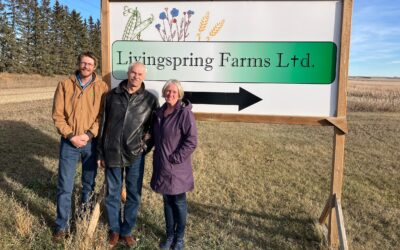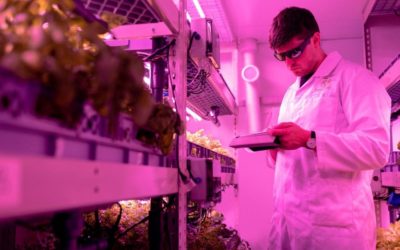As the Alberta government continues to make changes to how agriculture programs are delivered in the province, producer groups are looking for certainty on future spending.
With the United Conservative Party (UCP) over halfway through their first government mandate, they have made numerous changes to Alberta Agriculture and Forestry (AAF) with producer groups now more in charge of programs. But as producer groups work to fill the services void, they want more certainty on future plans for AAF.
“We need to know for the future where it’s going to be because anything to with research especially, it’s not year-to-year, it’s five-year or 10-year projects,” Dave Bishop, Alberta Barley board chair, says in a phone interview. “Are we going to have X amount of dollars, every year or is it going to change from year-to-year.”
Producer groups across the province are stepping up to take over programs which were previously run by the provincial government. The groups are understanding of the provincial financial situation and are willing to work with the government on solutions for providing agriculture programming but want assurance of future spending plans.
AAF expenses have varied over the last decade, provincial budget documents show. Between 2010 to 2020 the budget expenses for AAF have ranged from $872,886 to $1,940,760, with the lowest year being in 2020.
The New Democratic Party’s (NDP) budget projections ranged from $1,161,605 to $1,940,760 during their years in office. The first year the UCP took office in 2019, there was $1,410,540 in projected expenses for AAF, but in 2020 the budgetary numbers dropped 38 per cent to $872,886. Funding cuts were recorded for all departments/programs (except for debt servicing costs), with $0 being budgeted for climate change initiatives.
The 2020 budget documents note AAF is committed to the ongoing review of programs and services to ensure the best possible outcomes are being achieved for Albertans. It also notes the UCP are committed to reducing red tape. The ministry plans to have a one-third reduction in the number of regulatory requirements in its statutes, regulations, policies and forms by 2023.
“It’s been a constant state of transition since the new government took over,” Ward Toma, general manager of Alberta Canola, says in a phone interview. “The biggest issue that we need is either get on with it, get it done. Whatever they’re going to do, please let us know, so, that we can start working toward a new reality.”
The UCP’s have redirected funding and changed the government’s approach to AAF. One of the biggest changes has been to transition agricultural research in the province from a lab-based approach to a farmer-led program. The result has been the creation of Results Driven Agriculture Research (RDAR).
News releases from the province describe RDAR as a non-profit, arm’s-length agriculture research organization. The releases also states it takes the best parts of previous research models, such as Alberta Livestock and Meat Agency and Alberta Crop Industry Development Fund, in order to create the organization.
“I kind of looked at (RADR) as a bit of an opportunity for the producers to become more involved,” Bishop says. “We have a lot of farmer input now where we didn’t have hardly any before.”
RDAR is being supported through federal and provincial funding through the Canadian Agricultural Partnership (CAP), the group’s website says. Farmers, other governments and the private sector will provide co-funding. As of May, it was expected the new research organization would become incorporated and start funding projects by fall 2020.
While RDAR is still being developed, other modifications to AAF have already been implemented and are making visible changes to services offered. The provincial crop reports moved from a weekly publishing schedule to bi-weekly during July and August for 2020.
There have also been staff cuts across AAF. In 2019, 50 people were laid off in the ministry. In the 2020 budget AAF expected 277 full-time-equivalent job losses. The budget also indicated an expected 48 full-time-equivalent job losses at Agriculture Financial Services Corp and 125 full-time-equivalent job cuts at Alberta Innovates, which contributes to agriculture research. The government expected to make most of these cuts by not refilling vacant positions as employees retired.
The Ag-Info Centre crop, livestock or other one-to-one specialist services have also been a causality of the layoffs. As of March, the centre stopped offering specialized services, instead calls to it are now redirected to other government information services.
The main website for agriculture information called ‘Ropin’ the Web’ was shut down during the 2019 provincial election due to government communication laws. It has since not been reactivated, but the Alberta Forage Industry Network received CAP funding and launched ‘Farming the Web’ as an online marketplace for the forage and agriculture community this year. However, the new website does not include all of the other information which the former did. Some of the information from ‘Ropin’ the Web’ has been reposted on AAF’s website.
The Alberta Blue Book, which is an overview of all of crop protection products registered for use in Alberta, is now being published by the Alberta Wheat Commission supported by the Alberta Canola Producers Commission, Alberta Pulse Growers and Alberta Barley through CAP funding, it had previously been published by AAF. The provincial government published it on a cost recovery model which the producer groups plan to continue.
The commissions have also taken on the annual Agronomy Update conference. The Alberta Wheat Commission and Alberta Barley are spearheading planning efforts for the conference which will take place in January 2021.
Similar agriculture programs in Manitoba and Saskatchewan are handled by producer groups, Tom Steve, Alberta Barley and Wheat commissions general manager, points out in a phone interview. In the past, producers had relied on the government for agronomy information, but producer groups now do a lot of their own outreach.
“Maybe it’s just a sign of the times that these things are taken over by the crop commissions — because it’s our mandate. We focus on serving the producers of our commodity and helping them grow big crops and being profitable. And I think that’s just maybe evolution,” Steve says.





